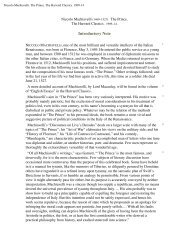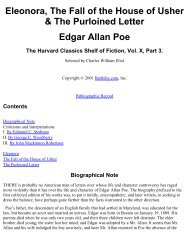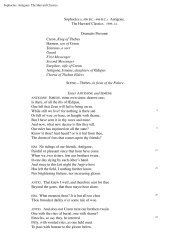Notre Dame de Paris - Bartleby.com
Notre Dame de Paris - Bartleby.com
Notre Dame de Paris - Bartleby.com
You also want an ePaper? Increase the reach of your titles
YUMPU automatically turns print PDFs into web optimized ePapers that Google loves.
If, instead of the characteristic monuments like those of which we have spoken, we examine the general<br />
aspect of the art from the sixteenth to the eighteenth century, we shall find everywhere the same<br />
evi<strong>de</strong>nces of <strong>de</strong>crepitu<strong>de</strong> and <strong>de</strong>cay. From the time of Francis II the form of the edifice lets the<br />
geometrical outline show through more and more, like the bony framework through the skin of an<br />
emaciated body. The generous curves of art give place to the cold and inexorable lines of geometry. An<br />
edifice is no longer an edifice, it is a polyhedron. Architecture, however, is at infinite pains to cover her<br />
nakedness, and hence the Greek pediment set in the Roman pediment and vice versa. It is always the<br />
Pantheon on the Parthenon, Saint-Peter’s at Rome. Such are the brick houses with stone corners of the<br />
time of Henri IV, the Place Royale, the Place Dauphine. Such are the churches of Louis XIII, heavy,<br />
squat, <strong>com</strong>pressed, with a dome like a hump. Thus, too, is the Mazarin architecture, the poor Italian<br />
pasticcio of the Quatre-Nations, the palaces of Louis XIV, mere court barracks, endless, frigid,<br />
wearisome; and finally, the style of Louis XV with its chicory-leaf and vermicelli ornaments, and all the<br />
warts and growths disfiguring that aged, toothless, <strong>de</strong>moralized coquette. From Francis II to Louis XV<br />
the malady progressed in geometrical ratio. The art is reduced to skin and bone, her life ebbs miserably<br />
away.<br />
Meanwhile, what of the art of printing? All the vital force taken from architecture streams to her. As<br />
architecture sinks, so printing rises and expands. The store of strength spent hitherto by human thought<br />
on edifices is now bestowed on books; till, by the sixteenth century, the press, grown now to the level of<br />
her shrunken rival, wrestles with her and prevails. In the seventeenth century she is already so absolute,<br />
so victorious, so firmly established on her throne, that she can afford to offer to the world the spectacle of<br />
a great literary era. In the eighteenth century, after long idleness at the Court of Louis XIV, she takes up<br />
again the ancient sword of Luther, thrusts it into Voltaire’s hand, and runs full tilt at that antiquated<br />
Europe whom she has already robbed of all architectural expression. Thus, as the eighteenth century ends<br />
she has ac<strong>com</strong>plished her work of <strong>de</strong>struction; with the nineteenth century she begins to construct.<br />
Now which of these two arts, we ask, represents in truth the course of human thought during three<br />
centuries; which of the two transmits, expresses, not only its fleeting literary and scholastic fashions, but<br />
its vast, profound, all-embracing ten<strong>de</strong>ncies? Which of the two has fitted itself like a skin, without a<br />
crease or gap, over that thousand-footed, never-resting monster, the human race? Architecture or<br />
Printing?<br />
Printing. Let no one mistake: architecture is <strong>de</strong>ad—<strong>de</strong>ad beyond recall, killed by the printed book,<br />
killed because it is less durable, killed because it is more costly. Every Cathedral represents a million.<br />
Imagine now the sums necessary for the rewriting of that architectural tome; for those countless edifices<br />
to spread once more over the land; to return to the days when their abundance was such that from the<br />
testimony of an eye-witness “you would have thought that the world had cast off its old raiment and clad<br />
itself anew in a white raiment of churches.” Erat enim ut si mundus, ipse excutiendo semet, rejecta<br />
vetustate, candidam ecclesiarum vestem indueret. (GLABER RUDOLPHUS.)<br />
A book takes so little time in the making, costs so little, and can reach so far. What won<strong>de</strong>r that human<br />
thought should choose that path? Though this is not to say that architecture will not, from time to time,<br />
put forth some splendid monument, some isolated master-piece. There is no reason why, un<strong>de</strong>r the reign<br />
of printing, we should not, some time or other, have an obelisk constructed, say, by an entire army out of<br />
melted cannon, as, un<strong>de</strong>r the reign of architecture, we had the Iliads, the Romants, the Mahabharatas, and<br />
the Nibelungen, built by whole nations with the wel<strong>de</strong>d fragments of a thousand epics. The great good<br />
fortune of possessing an architect of genius may befall the twentieth century, as Dante came to the










